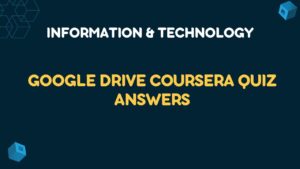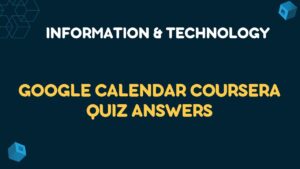Table of Contents
Preparing for the Google Cloud Professional Cloud Architect Exam Week 01 Quiz Answers
Q1. When you prepare using tables that compare different technologies…
- Read from the table-up. So that if you see a keyword in a question, you will recognize which associated technology in the heading row is a candidate for the solution.
- You don’t really need to know the characteristics of each technology. So it is safe to ignore tables. They have too much information anyway.
Q2. Why is knowledge of a layered model a recommended preparation?
- Because it helps organize information and prevent confusion.
- Because it tells you which part of a case or problem is most important.
Q3. Which Cloud Storage type is best for data accessed on average once or less during a 30 to 90 day period?
- Archive
- Coldline
- Nearline
- Standard
Q1. What service was recommended as a way to model solution resources and generate a general cost estimation?
- Google sheets
- Pricing calculator
Q2. What was the key point made about resilient failover design?
- If the load changes, the capacity has to be revisited, or the ability of the design to handle a failover could be lost.
- If you account for failover in you initial design you will never need to worry about it again.
Q3. What is the feature that bridges monitoring and incident response in the Site Reliability Engineering model?
- Billing
- Alerts
Q4. Customer Supplied Encryption Keys (CSEK) is for which purpose:
- Keep keys on-premises, and use them to encrypt your cloud services.
- Data is encrypted before it is sent to the cloud.
Graded Practice Exam Quiz Answers & Ungraded Practice Exam Quiz Answers
Q1. An existing application uses WebSockets. To help migrate the application to the cloud you should:
- Redesign the application to use HTTP streaming.
- Redesign the application to use distributed sessions instead of WebSockets.
- Do nothing to the application. HTTP(S) load balancing natively supports WebSocket proxying.
- Review websocket encryption requirements with the security team.
Q2. How to store data to be accessed once a month and not needed after five years.
- Standard Storage class, lifecycle policy to delete after 5 years.
- Standard Storage class, lifecycle policy change to Coldline after 5 years.
- Nearline class, lifecycle policy change to Coldline after 5 years.
- Nearline class, lifecycle policy to delete after 5 years.
Q3. Multi-petabyte database for analysts that only know SQL and must be available 24 x 7.
- Cloud Storage
- Cloud SQL
- BigQuery
- Datastore
Q4. Simply and reliably clone a Linux VM to another project in another region.
- Use Linux dd and netcat to stream the root disk to the new VM.
- Snapshot the root disk and select it for the new VM.
- Create an image from the root disk with Linux dd, create a disk from the image, and use it in the new VM.
- Snapshot the root disk, create an image, and use the image for the new VM root disk.
Q5. A company has this business requirement: “Improve security by defining and adhering to a set of security and Identity and Access Management (IAM) best practices for cloud.”
Company security has locked out SSH access to production VMs. How can operations manage the VMs?
- Configure a VPN to allow SSH access to VMs.
- Develop a Cloud API application for all operations actions.
- Grant operations team access to use Cloud Shell.
- Develop an application that grants temporary SSH access.
Q6. What security strategy would you recommend for PII (Personally Identifiable Information) data on Cloud Storage?
- Signed URL with expiration.
- Read-only access to users, and default ACL on bucket.
- No Cloud IAM roles to users, and granular ACLs on bucket.
- Public access, random names, and share URLs in confidence.
Q7. Which platform features of Google Cloud support TerramEarth’s business requirements?
- Google has many years of experience with containers.
- Google Cloud provides automatic discounts with increased usage.
- Vertex AI and BigQuery are designed for petabyte scale.
- Google Cloud bills per minute, saving costs compared to hourly billing.
Q8. How can MountKirk Games meet its scaling requirements while providing insights to investors?
- Import MySQL game statistics to BigQuery for provisioning analysis and indicator reporting.
- Use Cloud Monitoring custom metrics for autoscaling and reporting.
- Autoscale based on CPU load and use Google Data Studio to share metrics.
- Autoscale based on network latency as a measure of user experience.
Q9. How to test a risky update to an App Engine application requiring live traffic?
- Deploy as default temporarily, then roll it back.
- Create a separate isolated test project and onboard users.
- Create a second App Engine project, then redirect a subset of users.
- Deploy a new version, use traffic splitting to test a percentage.
Q10. A microservice has intermittent problems that bursts logs. How can you trap it for live debugging?
- Log into machine with microservice and wait for the log messages.
- Look for error in Error Reporting dashboard.
- Configure microservice to send traces to Cloud Trace.
- Set a log metric in Cloud Logging, alert on it past a threshold.
Q11. A company wants penetration security testing that primarily matches an end user perspective. What action would you take?
- Notify Google you are going to run a penetration test.
- Deploy scanners in the cloud and test from there.
- Use on prem scanners over VPN.
- Use on prem scanners over public Internet.
Q12. A sales company runs weekly resiliency tests of the current build in a separate environment by replaying the last holiday sales load. What can improve resiliency?
- Apply twice the load to the test.
- Run the resiliency tests daily instead of weekly.
- Use preemptible instances.
- Develop a script that mimics a zone outage and add it to the test.
Q13. Release failures keep causing rollbacks in a web application. Fixes to the QA process reduced rollbacks by 80%. What additional steps can you take?
- Replace the platform’s relational database systems with a NoSQL database.
- Fragment the monolithic platform into microservices.
- Remove the QA environment. Start executing canary releases.
- Remove the platform’s dependency on relational database systems.
Q14. How will the application parts developed by separate project teams communicate over RFC1918 addresses?
- Single project, same VPC
- Shared VPC, each project a service of the Shared VPC project
- Parts communicate using HTTPS
- Communicate over global load balancers, one per project
Q15. How can you minimize the cost of storing security video files that are processed repeatedly for 30 days?
- Standard Storage, then move to Coldline Storage or Archive Storage after 30 days.
- Nearline Storage, then move to Coldline Storage after 30 days.
- Standard Storage, then move to Nearline Storage after 30 days.
- Keep the files in Standard Storage.
Q16. A company’s security team has decided to standardize on AES256 for storage device encryption. Which strategy should be used with Compute Engine instances?
- Select SSDs rather than HDDs to ensure AES256 encryption.
- Use the linux dm-crypt tool for whole-disk encryption.
- Use Customer Supplied Encryption Keys (CSEK).
- Use openSSL for AES256 file encryption.
Q17. Which Cloud IAM roles would you assign for security auditors requiring visibility across all projects?
- Org viewer, project owner
- Org viewer, project viewer
- Org admin, project browser
- Project owner, network admin
Q18. A car reservation system has long-running transactions. Which one of the following deployment methods should be avoided?
- Execute canary releases.
- Perform A/B testing prior to release.
- Introduce a blue-green deployment model.
- Introduce a pipeline deployment model.
Q19. You need to implement back-out/rollback for a website with 100s of VMs. The site has frequent critical updates. Which of the following is the correct solution?
- Create a Nearline copy of static data in Cloud Storage.
- Create a snapshot of each VM prior to update, in case of failure.
- Use managed instance groups with the “update-instances” command when starting a rolling update.
- Only deploy changes using Deployment Manager templates.
Q25. Last week a region had a 1% failure rate in web tier VMs? How should you respond?
- Monitor the application for a 5% failure rate.
- Duplicate the application on prem to compensate for failures in the cloud.
- Perform a root cause analysis, reviewing cloud provider and deployment details to prevent similar future failures.
- Halt all development until the application issue can be found and fixed.
- There are fewer LookML parameters to write in the dimension_group definition
All Course Quiz Answers of Preparing for Google Cloud Certification: Cloud Architect Professional Certificate
Google Cloud Fundamentals: Core Infrastructure Coursera Quiz Answers
Essential Google Cloud Infrastructure: Foundation Coursera Quiz Answers
Essential Google Cloud Infrastructure: Core Services Coursera Quiz Answers
Elastic Google Cloud Infrastructure: Scaling and Automation Coursera Quiz Answers
Reliable Google Cloud Infrastructure: Design and Process Coursera Quiz Answers
Architecting with Google Kubernetes Engine: Foundations Coursera Quiz Answers
Preparing for the Google Cloud Professional Cloud Architect Exam Quiz Answers



